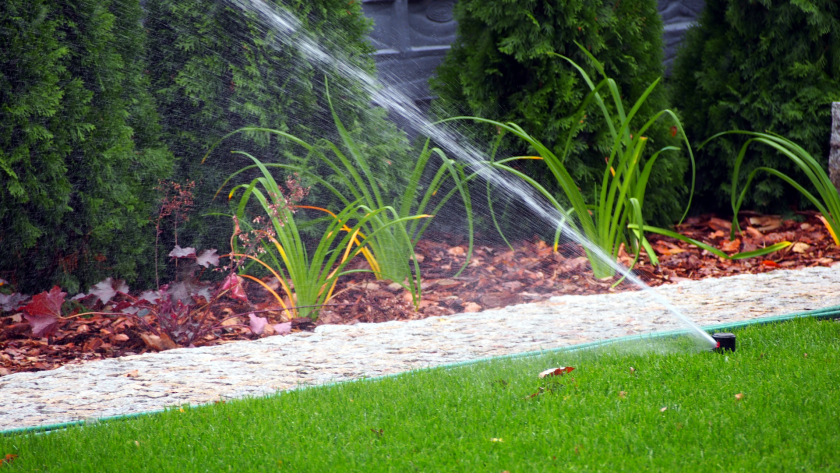When keeping your lawn and garden healthy, you can’t let nature do its thing. Irrigation systems help plants receive the water and nutrients they need to thrive. Though sprinkler systems have been around for centuries, new irrigation technology has made them more convenient, effective, and affordable than ever before.
It’s summertime, and it’s hot. That means your lawn needs water to survive. But you don’t want to keep the sprinklers on all day and night, watering baby plants. To make sure that they are watered enough and as per requirement, you should consider introducing an irrigation system in your landscaping plan. It can keep your lawn green and lush while allowing grass to grow. And, if done right, it can save you money on your water bill.
An irrigation system is much like a sprinkler, except it’s set up to work consistently for a certain amount of time. The time varies depending on your yard size, the number of zones, and how much rain you get. So, how do you know how long your sprinkler system should run? The amount of water your yard needs is dependent on how much of your yard is grass and how many plants you have. To determine the watering needs, you’ll need to measure your yard length from the base of your tallest plants to the base of your lowest plants. Multiply that length by 0.5, and that’s the amount of water your yard needs, on average, each day.
Irrigation system is a watering method that lets people know when it’s necessary to allow their grass to grow. These sprinkler systems are usually hidden underground, but they can also be installed above ground. Keeping it concealed or out in the open is a choice that solely depends on the homeowner. However, it may sometimes be necessary to consult landscaping experts (sites similar to https://tampalandscapingcompanies.com/ could be helpful in this regard) who can assist with properly installing the irrigation system, so that the overall look of the yard turns out impressive.
Needless to say, there are many reasons to install an irrigation system, including reducing water waste. An irrigation system can also help homeowners keep their lawns healthy and green by watering them at the right time of day. Homeowners can install their irrigation systems, but it’s always best to hire a professional to do the work. The professional will dig, install the pipes, and program the sprinklers.
Tips on how to install an irrigation system
Installing an irrigation system can be daunting, but you can get the job done with these helpful tips. First, start by planning how you would like your new system to work, considering the yard’s size, type of soil, and how much water is usually needed. Next, decide what kind of sprinkler head you want and if you need a drip line system or an underground main. Finally, choose whether you want the sprinkler heads to be buried, staked, exposed, or some other style. If you are still unsure about the type of system to choose, you can contact a landscaping company (look at https://www.landscapingcompaniesatlanta.com/, if interested) that can help you with proper water management depending on the land size. The experts from such firms can access the land as well as the water needs and suggest the appropriate irrigation system that ensures low water wastage.
What are the types of irrigation systems?
- Drip irrigation system – With a drip irrigation system, your plants are watered slowly and at precisely measured intervals. Since you don’t over-water your plants, you’ll save money on water bills, and the time you can save on watering will mean less time spent out gardening, so it’s a great time saver.
- Sprinkler irrigation system – Installing an irrigation system in your yard can be a huge help, especially if you live in an arid area. A sprinkler system allows you to water your lawn even when everyone in the household is at work or away, and your landscape will keep looking nice. Additionally, you could consider investing in attachments like a quality filter wire cloth or automated timers to further enhance the efficiency and performance of your irrigation system.
- Centre pivot irrigation system – Fitting an irrigation system can hugely impact your gardening, landscaping, and farming. When installed correctly, a center pivot irrigation system can provide water where it is needed quickly and efficiently.
- Furrow irrigation system – Furrow irrigation systems are named after how they irrigate the soil: by placing small holes at regular intervals across the surface of the field. Water is pumped across the soil from the main pipe to channels before seeping into the soil. These irrigation systems reduce evaporation, ensuring water reaches the roots. They are designed to water fields evenly and can be manually or fully automated.
- Terraced irrigation system – The terrace irrigation system is a perforated pipe system that delivers water to your plants. This type of irrigation system is an outdoor watering system that’s similar to drip irrigation, but terrace systems are what’s installed on terraces. Terraced irrigation systems differ from drip irrigation because the permeable pipes in the terrace irrigation system are filled with water and run continuously. In contrast, drip irrigation only runs when the irrigation head is placed over an outlet.




